Base Station Selection for Hybrid TDOA/RTT/DOA Positioning in Mixed LOS/NLOS Environment
Abstract
1. Introduction
2. System Model
3. GDOP for The Hybrid TDOA/RTT/DOA Positioning
4. GDOP-Assisted Base Station Selection Method
- Identify the channel condition of BSs and classify LOS BSs as the selected BSs.
- Estimate an initial position result.
- Find the unselected BS which could reduce GDOP most.
- Determine whether to mark the BS found in the step 3 as selected. If yes, jump back to step 2.
5. Simulation Results and Analysis
5.1. Simulation Scenario
5.2. GDOP Analysis for The Hybrid Positioning
5.3. Simulation Result of Positioning Based on the Proposed GDOP-Assisted BS Selection Method
6. Conclusions
Author Contributions
Funding
Acknowledgments
Conflicts of Interest
References
- Zafari, F.; Gkelias, A.; Leung, K. A Survey of Indoor Localization Systems and Technologies. IEEE Commun. Surv. Tutor. 2019, 21, 1–32. [Google Scholar] [CrossRef]
- Witrisal, K.; Hinteregger, S.; Kulmer, J.; Leitinger, E.; Meissner, P. High-accuracy positioning for indoor applications: RFID, UWB, 5G, and beyond. In Proceedings of the 2016 IEEE International Conference on RFID, RFID 2016, Orlando, FL, USA, 2–5 May 2016; pp. 1–7. [Google Scholar]
- del Peral-Rosado, J.A.; Raulefs, R.; López-Salcedo, J.A.; Seco-Granados, G. Survey of Cellular Mobile Radio Localization Methods: From 1G to 5G. IEEE Commun. Surv. Tutor. 2018, 20, 1124–1148. [Google Scholar] [CrossRef]
- 3GPP TS 22.261 Service Requirements for the 5G System (V16.7.0). Available online: https://portal.3gpp.org/desktopmodules/Specifications/SpecificationDetails.aspx?specificationId=3107 (accessed on 3 May 2020).
- 3GPP TR 22.872 Study on Positioning Use Cases (V16.1.0). Available online: https://portal.3gpp.org/desktopmodules/Specifications/SpecificationDetails.aspx?specificationId=3280 (accessed on 10 July 2019).
- Goldoni, E.; Prando, L.; Vizziello, A.; Savazzi, P.; Gamba, P. Experimental data set analysis of RSSI-based indoor and outdoor localization in LoRa networks. Internet Technol. Lett. 2019, 2, e75. [Google Scholar] [CrossRef]
- Farnham, T. Indoor localisation of iot devices by dynamic radio environment mapping. In Proceedings of the IEEE 5th World Forum Internet Things, WF-IoT 2019, Limerick, Ireland, 15–18 April 2019; pp. 340–345. [Google Scholar]
- Koivisto, M.; Hakkarainen, A.; Costa, M.; Kela, P.; Leppänen, K.; Valkama, M. High-Efficiency Device Positioning and Location-Aware Communications in Dense 5G Networks. IEEE Commun. Mag. 2017, 55, 188–195. [Google Scholar] [CrossRef]
- 3GPP TR 38.855 Study on NR Positioning Support (V16.0.0). Available online: https://portal.3gpp.org/desktopmodules/Specifications/SpecificationDetails.aspx?specificationId=3501 (accessed on 15 March 2020).
- Liu, Q.; Liu, R.; Wang, Z.; Zhang, Y. Simulation and analysis of device positioning in 5G ultra-dense network. In Proceedings of the 2019 15th International Wireless Communication Mobile and Computing Conference IWCMC 2019, Tangier, Morocco, 24–28 June 2019; pp. 1529–1533. [Google Scholar]
- Li, W.; Yuan, T.; Wang, B.; Tang, Q.; Li, Y.; Liao, H. GDOP and the CRB for positioning systems. IEICE Trans. Fundam. Electron. Commun. Comput. Sci. 2017, E100A, 733–737. [Google Scholar] [CrossRef]
- Cong, L.; Zhuang, W. Non-line-of-sight error mitigation in mobile location. IEEE Trans. Wirel. Commun. 2005, 4, 560–573. [Google Scholar] [CrossRef]
- Shahmansoori, A.; Garcia, G.E.; Destino, G.; Seco-Granados, G.; Wymeersch, H. Position and Orientation Estimation Through Millimeter-Wave MIMO in 5G Systems. IEEE Trans. Wirel. Commun. 2018, 17, 1822–1835. [Google Scholar] [CrossRef]
- Dammann, A.; Raulefs, R.; Zhang, S. On prospects of positioning in 5G. In Proceedings of the 2015 IEEE International Conference on Communication Workshop, ICCW 2015, London, UK, 8–12 June 2015; pp. 1207–1213. [Google Scholar]
- Menta, E.Y.; Malm, N.; Jantti, R.; Ruttik, K.; Costa, M.; Leppanen, K. On the Performance of AoA-Based Localization in 5G Ultra-Dense Networks. IEEE Access 2019, 7, 33870–33880. [Google Scholar] [CrossRef]
- Grosicki, E.; Abed-Meraim, K. A new trilateration method to mitigate the impact of some non-line-of-sight errors in TOA measurements for mobile localization. In Proceedings of the ICASSP, IEEE International Conference on Acoustics, Speech and Signal Processing, Philadelphia, PA, USA, 23 March 2005; Volume 4, pp. iv/1045–iv/1048. [Google Scholar]
- Bartelmaos, S.; Abed-Meraim, K.; Grosicki, E. General selection criteria for mobile location in NLoS situations. IEEE Trans. Wirel. Commun. 2008, 7, 4393–4403. [Google Scholar] [CrossRef]
- Wu, S.; Li, J.; Liu, S. Improved localization algorithms based on reference selection of linear least squares in LOS and NLOS environments. Wirel. Pers. Commun. 2013, 68, 187–200. [Google Scholar] [CrossRef]
- Gazzah, L.; Najjar, L. Enhanced cooperative group localization with identification of LOS/NLOS BSs in 5G dense networks. Ad Hoc Netw. 2019, 89, 88–96. [Google Scholar] [CrossRef]
- Yu, K.; Guo, Y.J. Statistical NLOS identification based on AOA, TOA, and signal strength. IEEE Trans. Veh. Technol. 2009, 58, 274–286. [Google Scholar] [CrossRef]
- Sharp, I.; Yu, K.; Guo, Y.J. GDOP analysis for positioning system design. IEEE Trans. Veh. Technol. 2009, 58, 3371–3382. [Google Scholar] [CrossRef]
- Deng, Z.; Wang, H.; Zheng, X.; Fu, X.; Yin, L.; Tang, S.; Yang, F. A closed-form localization algorithm and GDOP analysis for multiple TDOAs and single TOA based hybrid positioning. Appl. Sci. 2019, 9, 4935. [Google Scholar] [CrossRef]
- Kihara, M.; Okada, T. A Satellite Selection Method and Accuracy for the Global Positioning System. Navigation 1984, 31, 8–20. [Google Scholar] [CrossRef]
- Huang, P.; Rizos, C.; Roberts, C. Satellite selection with an end-to-end deep learning network. GPS Solut. 2018, 22, 108. [Google Scholar] [CrossRef]
- Yu, L.; Shijun, T. Vertical positioning technologies and its application of pseudolites augmentation. In Proceedings of the 4th International. Conference on Wireless. Communications, Networking and Mobile Computing WiCOM 2008, Dalian, China, 12–17 October 2008; pp. 1–3. [Google Scholar]
- Del Peral-Rosado, J.A.; Bavaro, M.; López-Salcedo, J.A.; Seco-Granados, G.; Chawdhry, P.; Fortuny-Guasch, J.; Crosta, P.; Zanier, F.; Crisci, M. Floor detection with indoor vertical positioning in LTE femtocell networks. In Proceedings of the 2015 IEEE Globecom Work. GC Wkshps 2015, San Diego, CA, USA, 6–10 December 2015; pp. 1–6. [Google Scholar]
- Li, Y.-Y.; Qi, G.-Q.; Sheng, A.-D. General analytical formula of GDOP for TOA target localisation. Electron. Lett. 2018, 54, 381–383. [Google Scholar] [CrossRef]
- Yu, K. 3-D localization error analysis in wireless networks. IEEE Trans. Wirel. Commun. 2007, 6, 3473–3481. [Google Scholar]
- Li, W.; Wei, P.; Xiao, X. A robust TDOA-based location method and its performance analysis. Sci. China Ser. F Inf. Sci. 2009, 52, 876–882. [Google Scholar] [CrossRef]
- Teng, Y.; Wang, J.; Huang, Q.; Liu, B. New characteristics of weighted GDOP in multi-GNSS positioning. GPS Solut. 2018, 22, 74. [Google Scholar] [CrossRef]
- Chen, C.S.; Chiu, Y.J.; Lee, C.T.; Lin, J.M. Calculation of weighted geometric dilution of precision. J. Appl. Math. 2013, 2013. [Google Scholar] [CrossRef]
- Weisberg, S. Applied Linear Regression; Wiley-Interscience: Hoboken, NJ, USA, 2005; Volume 528, ISBN 0471663794. [Google Scholar]
- 3GPP TR 38.901 Study on Channel Model for Frequencies from 0.5 to 100 GHz (V16.1.0). Available online: https://portal.3gpp.org/desktopmodules/Specifications/SpecificationDetails.aspx?specificationId=3173 (accessed on 15 March 2020).
- Cheung, K.W.; So, H.C.; Ma, W.K.; Chan, Y.T. A constrained least squares approach to mobile positioning: Algorithms and optimality. EURASIP J. Appl. Signal Process. 2006, 2006, 1–23. [Google Scholar] [CrossRef]
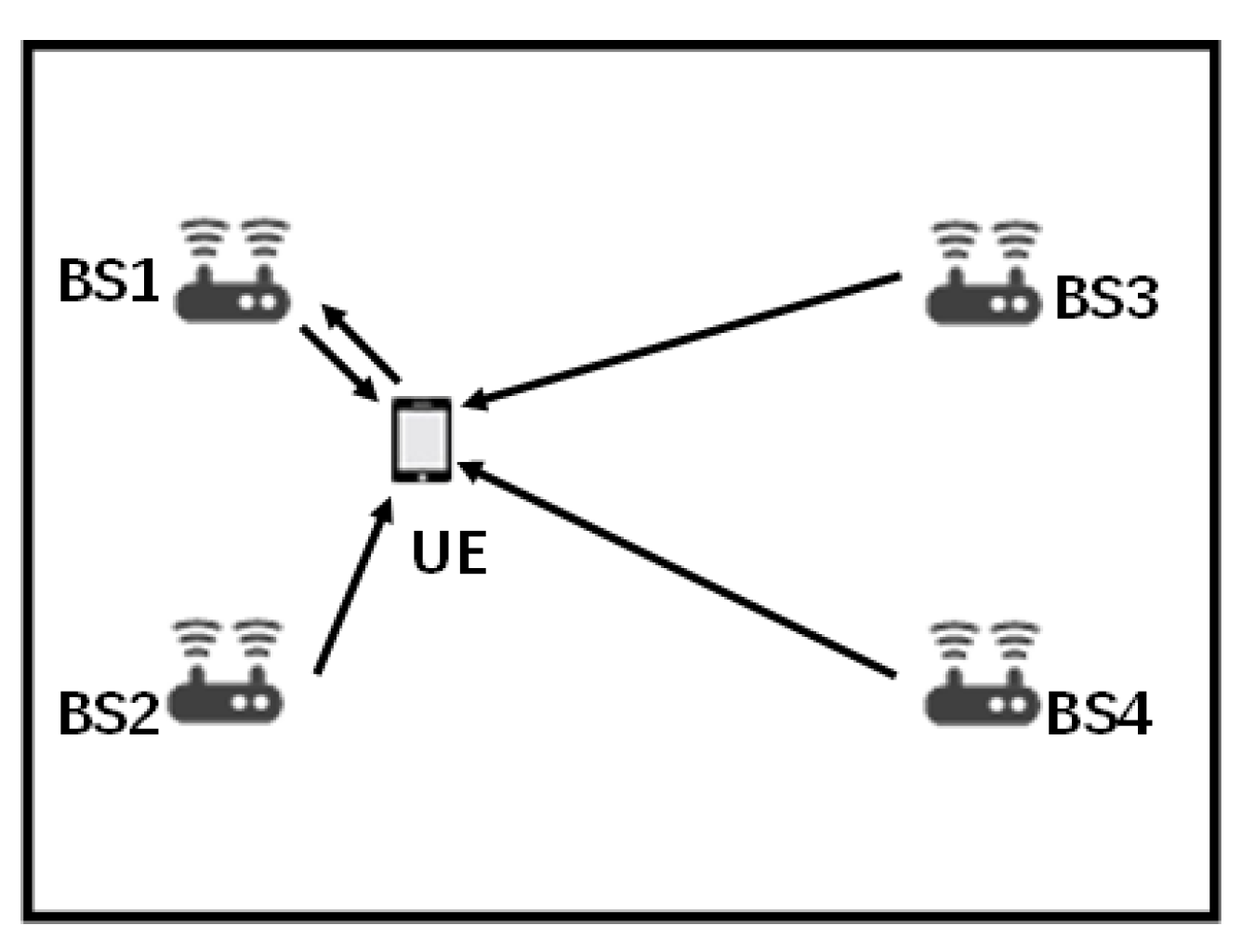
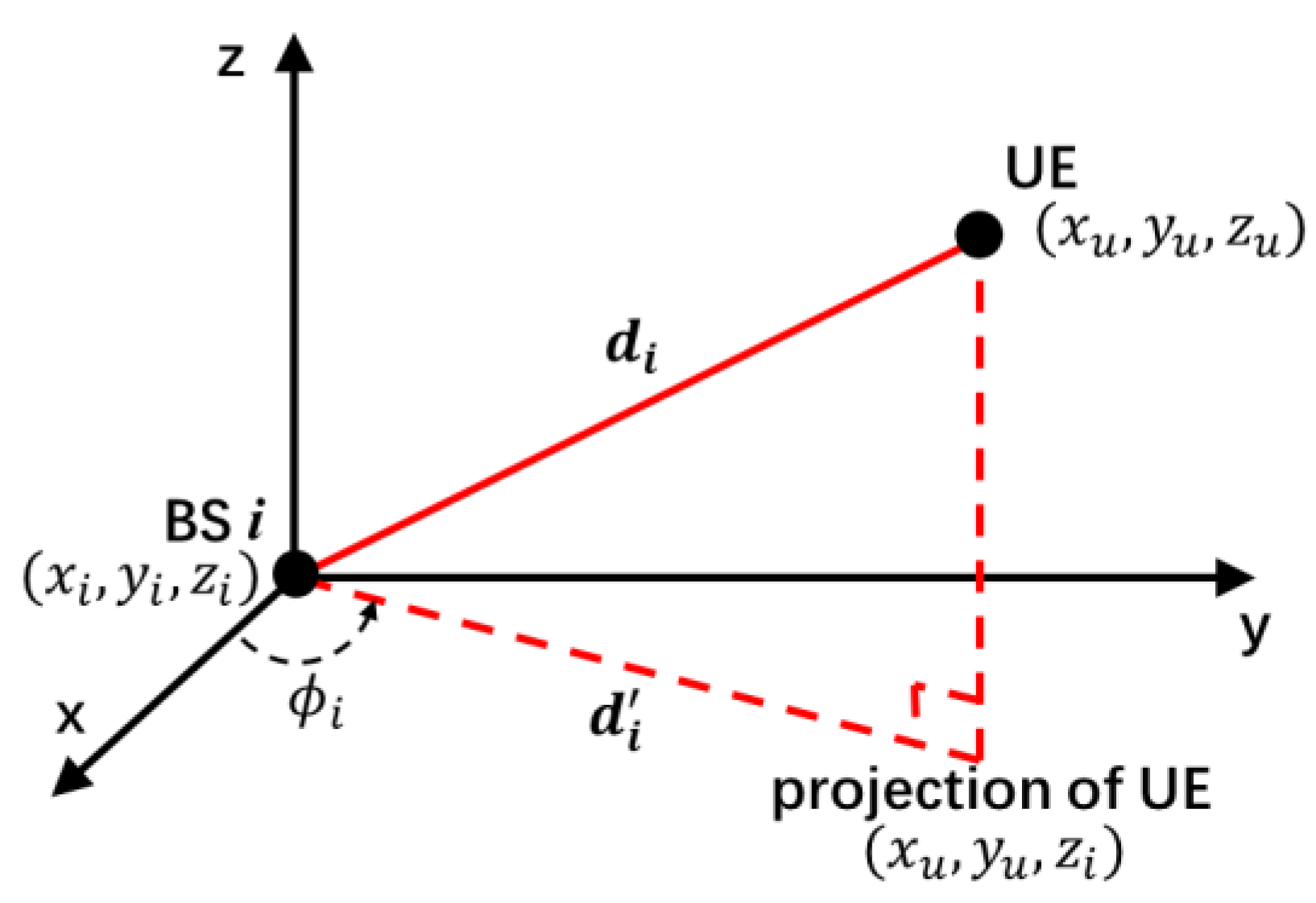

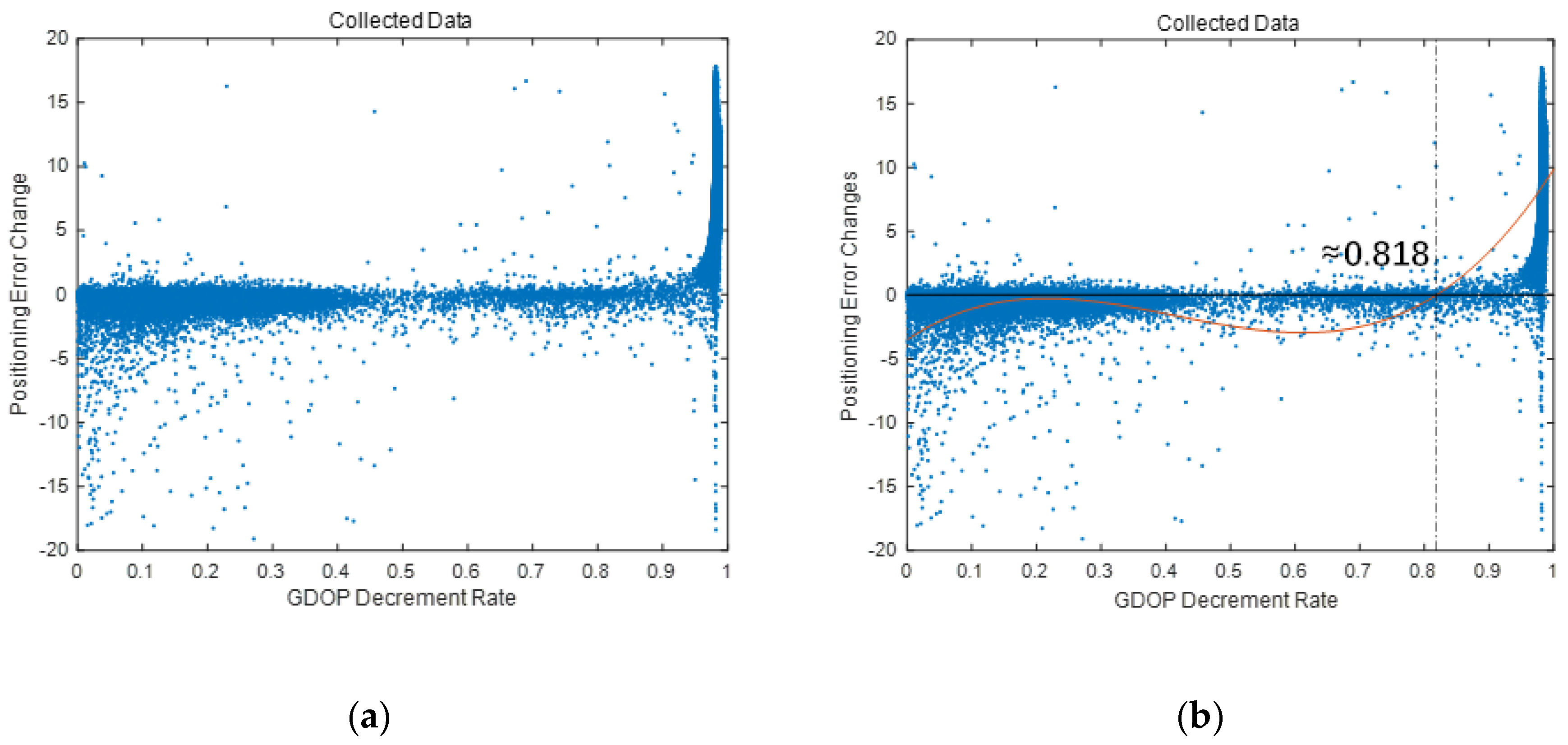
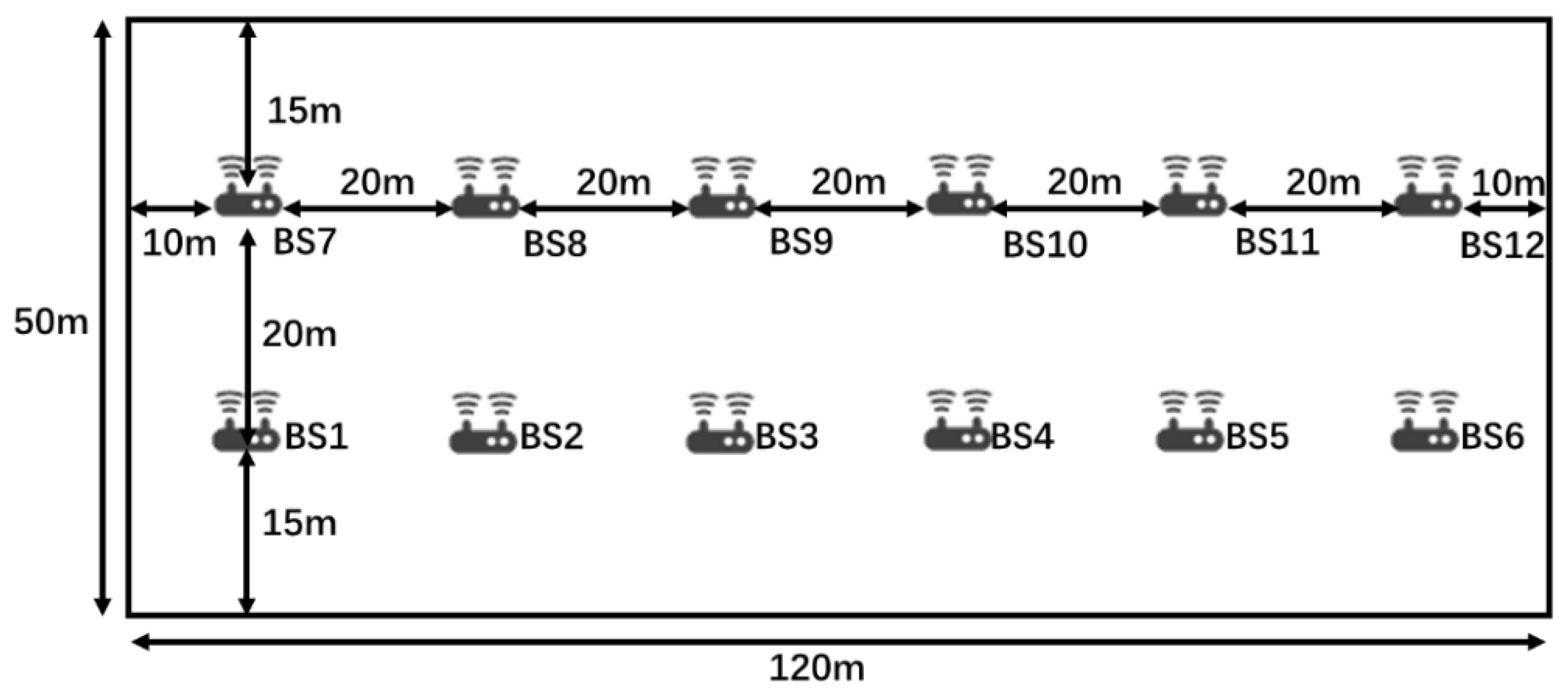
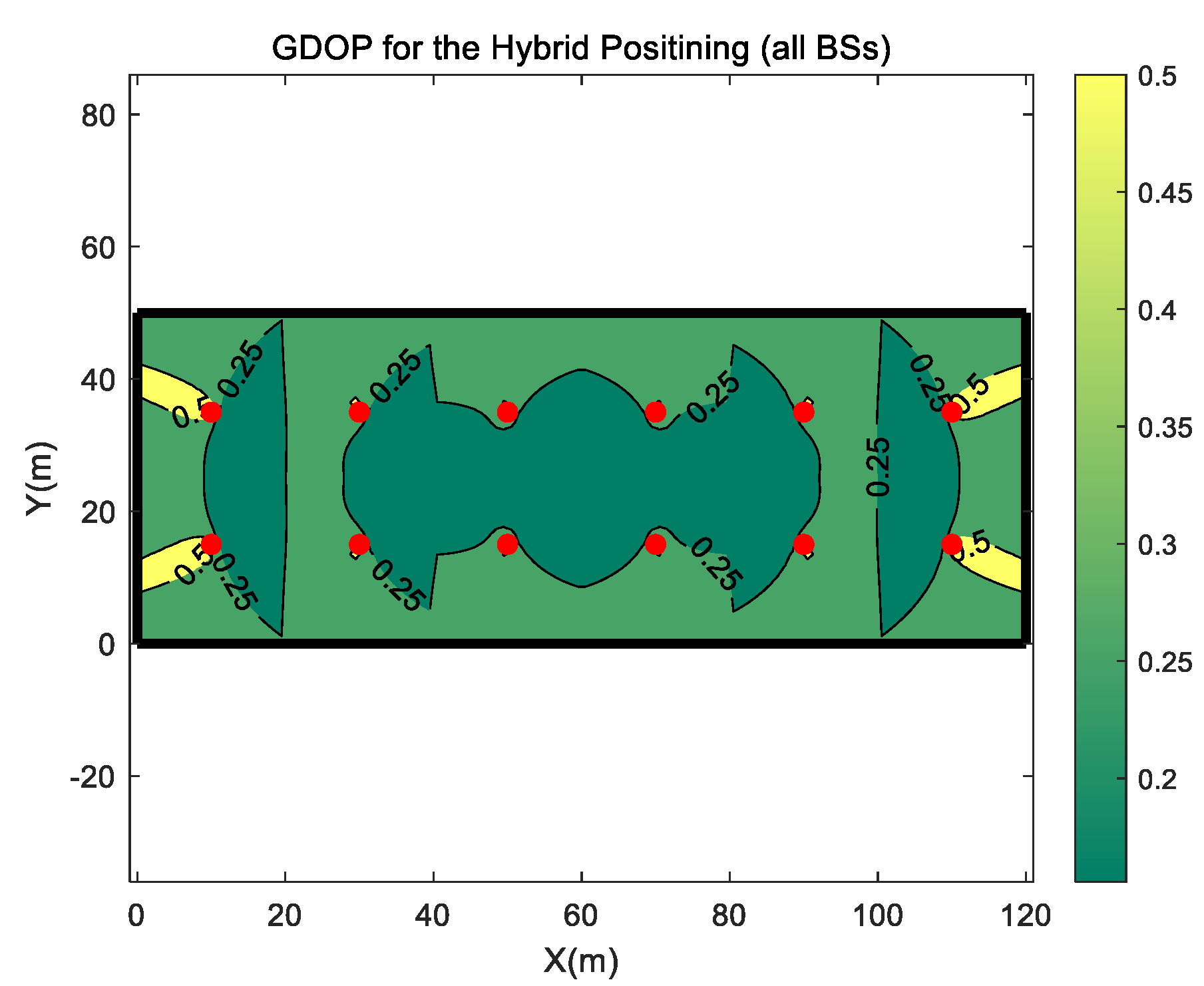
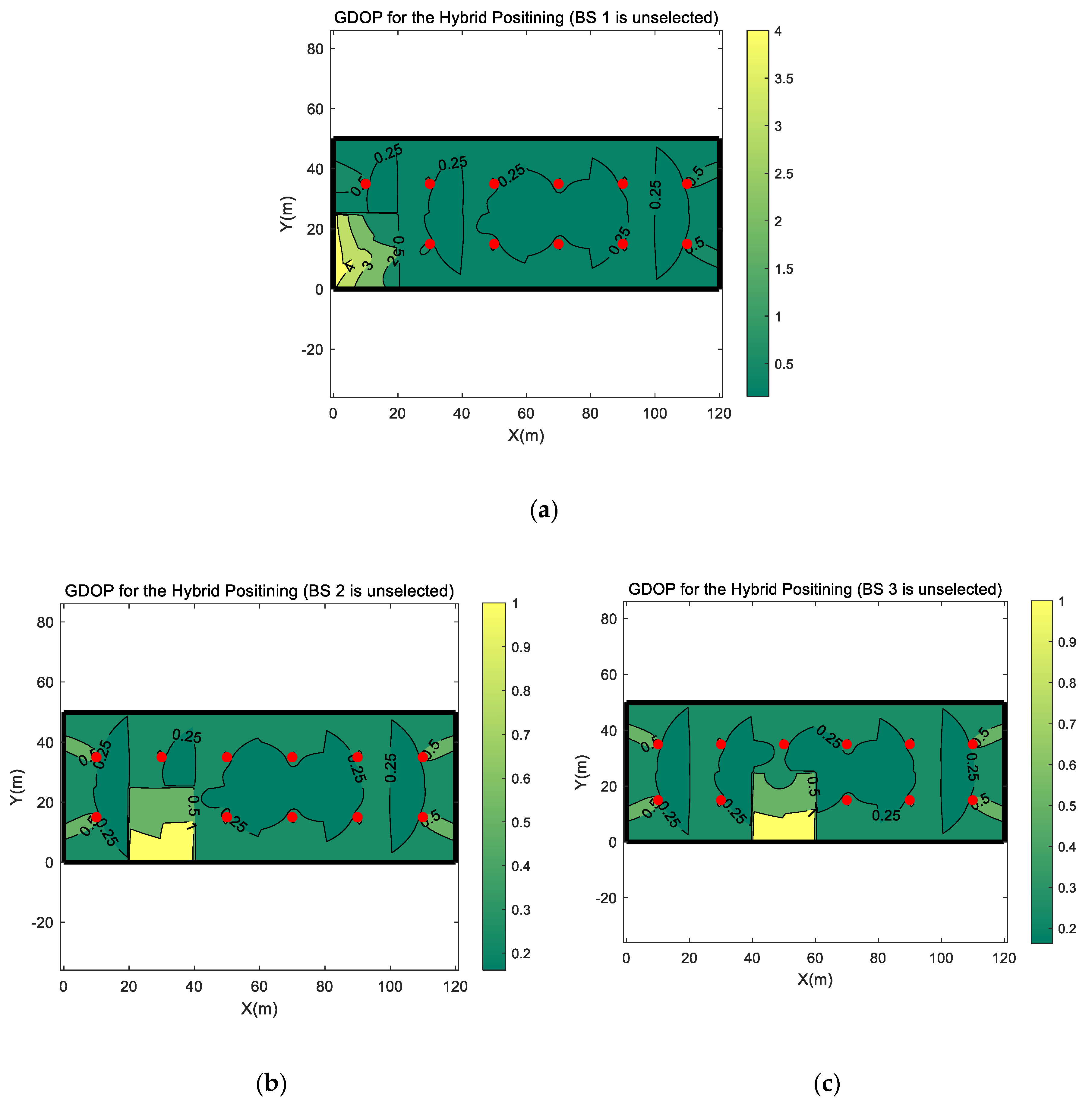



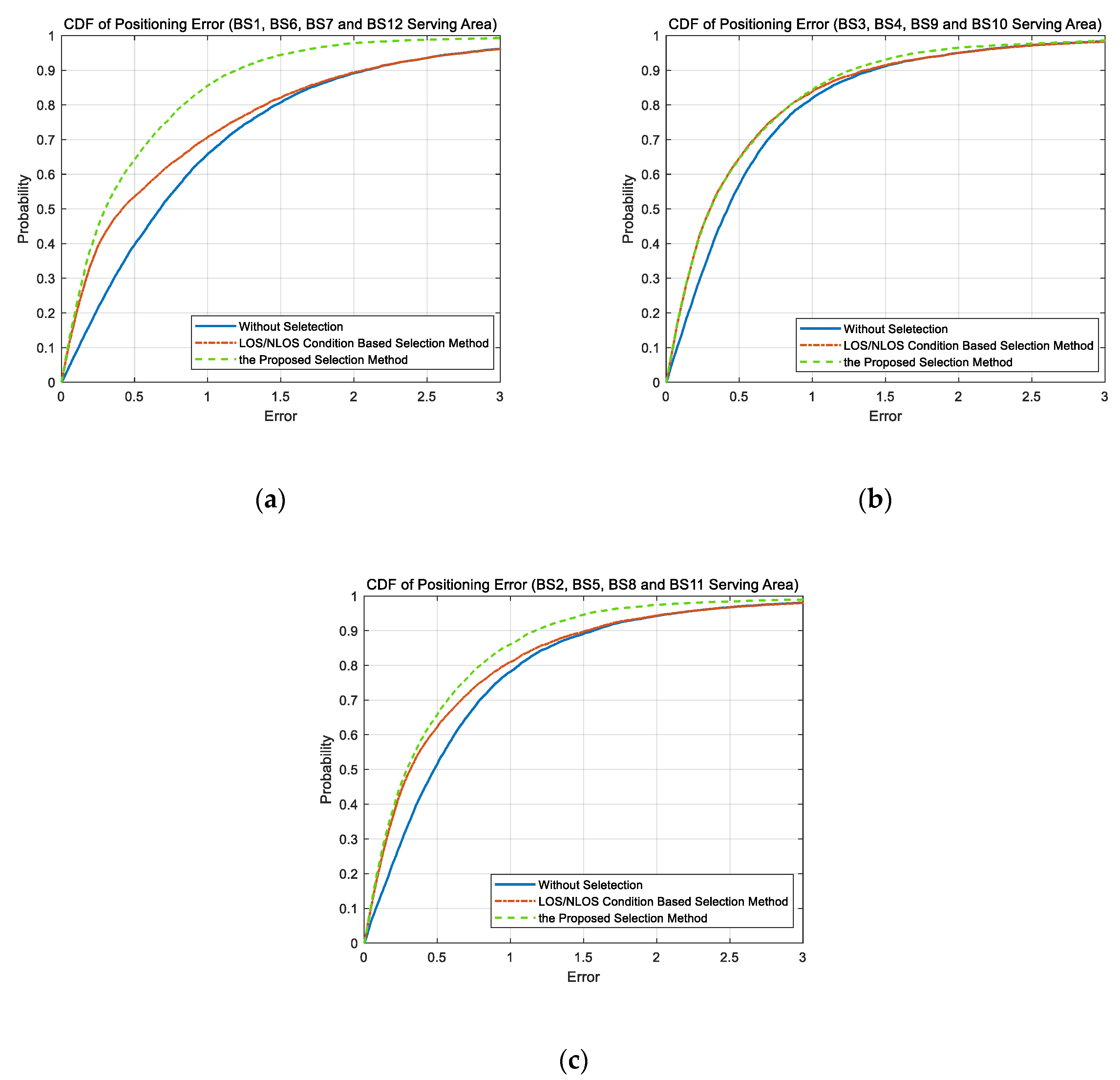
| Symbol | Meaning |
|---|---|
| DOA ranging result | |
| position of BS i | |
| Variance of DOA measurement error | |
| Variance of RTT measurement error | |
| Variance of TDOA measurement error | |
| Real distance between UE to BS i | |
| Distance difference between to | |
| Real distance from projection of UE to BS i | |
| Vector of measurement errors | |
| DOA measurement error of signal from UE to BS 1 | |
| Measurement error, refers to all measurement errors including , , and | |
| TDOA measurement error between signals from BS i and BS 1 to UE | |
| RTT measurement error of UE to BS 1 | |
| Positioning error on X-axis | |
| Positioning error on Y-axis | |
| Functional relationship between UE positioning result and measurement error, refers to all of , and | |
| Functional relationship between UE positioning result and DOA measurement error | |
| Functional relationship between UE positioning result and RTT measurement error | |
| Functional relationship between UE positioning result and TDOA measurement error | |
| The real azimuth angle between UE to BS 1 | |
| The TDOA ranging result | |
| The RTT ranging result | |
| u | The position of UE |
| The error of UE position estimation result | |
| UE’s real location | |
| Position estimation result |
© 2020 by the authors. Licensee MDPI, Basel, Switzerland. This article is an open access article distributed under the terms and conditions of the Creative Commons Attribution (CC BY) license (http://creativecommons.org/licenses/by/4.0/).
Share and Cite
Deng, Z.; Wang, H.; Zheng, X.; Yin, L. Base Station Selection for Hybrid TDOA/RTT/DOA Positioning in Mixed LOS/NLOS Environment. Sensors 2020, 20, 4132. https://doi.org/10.3390/s20154132
Deng Z, Wang H, Zheng X, Yin L. Base Station Selection for Hybrid TDOA/RTT/DOA Positioning in Mixed LOS/NLOS Environment. Sensors. 2020; 20(15):4132. https://doi.org/10.3390/s20154132
Chicago/Turabian StyleDeng, Zhongliang, Hanhua Wang, Xinyu Zheng, and Lu Yin. 2020. "Base Station Selection for Hybrid TDOA/RTT/DOA Positioning in Mixed LOS/NLOS Environment" Sensors 20, no. 15: 4132. https://doi.org/10.3390/s20154132
APA StyleDeng, Z., Wang, H., Zheng, X., & Yin, L. (2020). Base Station Selection for Hybrid TDOA/RTT/DOA Positioning in Mixed LOS/NLOS Environment. Sensors, 20(15), 4132. https://doi.org/10.3390/s20154132





